
Anne Frank wasn’t the only teenager who lost her childhood to war. Thousands of children and teenagers across Europe found their freedoms curtailed, their innocence lost, and their lives torn apart when the Second World War broke out. Probably hundreds of them kept diaries where they documented their everyday lives, their sufferings, their hopes. Only a few dozens of these secret diaries have been discovered after the war ended, and fewer still actually got published. The Dairy of Anne Frank is the most famous and the most widely read of all holocaust diaries. But it would be unfair to forget the rest.
Rutka Laskier
Rutka Laskier was 14 years old when she began writing her diary. As a Jew living in Poland, Rutka and her family faced ever-increasing violence and discrimination on the hands of the Germans occupying their country. Her family was forced to move to a Jewish ghetto in the city of Będzin early in the war, but she didn’t start writing until January 1943. She was able to write for only three months, before she was whisked away to Auschwitz. Her diary remained in the hands of Rutka's surviving friend for more than sixty years and was not released to the public until 2005.

Rutka’s story has many parallels with that of Anne Frank. Both were fourteen years old when they died, and both were survived by only their fathers. Both diaries document their everyday lives, their friendships, their first loves, their sexual awakening, and the horrors of the Nazi occupation.
The New York Times has an extract from her short diary. You can read it here.
For the full diary, get a copy from Amazon.
Renia Spiegel
Renia Spiegel’s mammoth diary runs to almost 700 pages spanning the last four years of her life, from the age of 15 to her death shortly after she turned 18. Her diary documents her experience living as a Jew in Przemyśl, in Poland, and like most teenagers of her age, she talks about ordinary topics such as school, friendships, and romance, as well as about her fear of the growing war and about being forced to move into the Przemyśl ghetto.
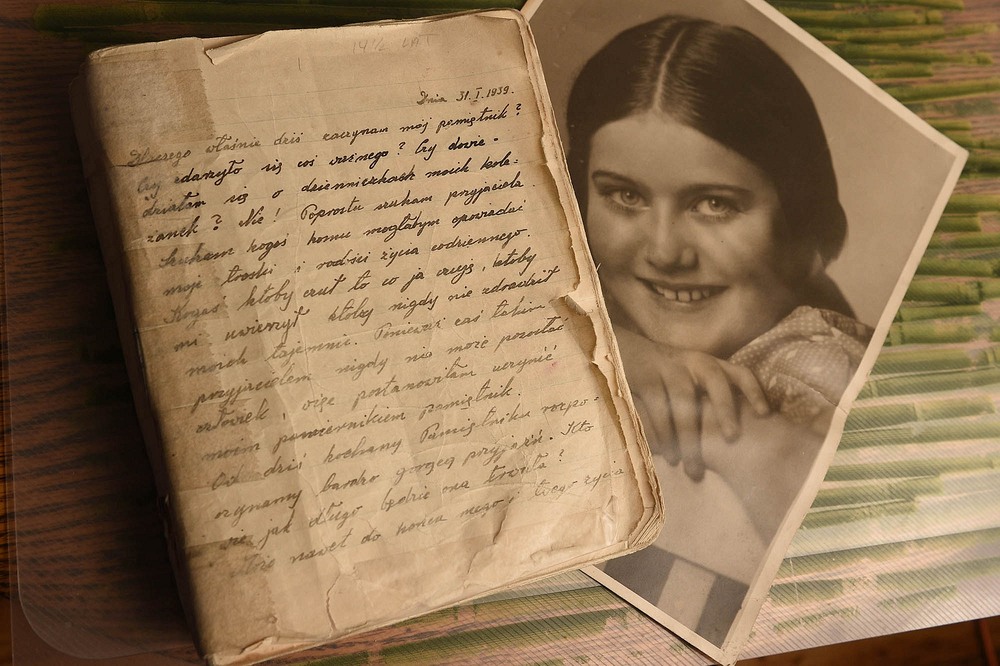
When the Przemyśl ghetto was established in July 1942, Renia and her sister were forced to move there along with her grandparents. After a few weeks, Renia’s boyfriend, Zygmunt Schwarzer, who had a work pass, smuggled the sisters out of the ghetto and hid them and his own parents in the attic of his uncle's house. Their hiding place was eventually exposed by an informer, and Renia along with Zygmunt’s parents were executed in the street.
After her death, Zygmunt took possession of the diary and wrote the final few entries about hiding Renia outside the ghetto and about her death. “Three shots! Three lives lost! It happened last night at 10:30 p.m. Fate decided to take my dearest ones away from me. My life is over. All I can hear are shots, shots shots....My dearest Renusia, the last chapter of your diary is complete,” he wrote.
Zygmunt survived the war and moved to United States where he gave the diary to Renia’s mother. The diary was first published in Polish only in 2016. The English translation will be published next month. You can pre-order the book on Amazon.
Eva Heyman
Eva Heyman was a Jewish Hungarian born in Nagyvarad, in present day Romania. Her parents got divorced and her mother moved away to Paris. So Eva lived with her grandparents in Budapest where her grandfather owned a pharmacy. The Germans reached Budapest on March 19, 1944. A month later, Eva and her grandparents were ordered to pack and move to the ghetto. In June 1944, Eva was deported to Auschwitz, where she died four months later. She was 13 years old.
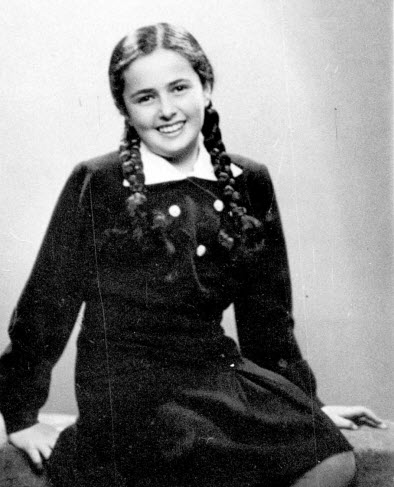
Eva's mother, Agnes Zsolt, was almost killed when she came to Budapest looking for her daughter. She was imprisoned at the Bergen-Belsen concentration camp but was rescued by Allied troops in 1945. She came back again to search for her daughter but found her diary instead. Upon reading her diary, her mother was so swaddled with grief that she committed suicide.
Heyman's diary was published first in Hungarian. It was translated into Hebrew in 1964, then into English in 1974.
Petr Ginz
Petr Ginz was born in 1928 in Prague. His father was Jewish and his mother was Catholic, which made him a “Mischlinge”—children of a “mixed marriage”. According to the anti-Jewish laws of the Third Reich, such children were to be deported to a concentration camp at the age of 14.
By December 1941, deportations from Prague to the Theresienstadt ghetto had begun, and the Ginz family was gradually broken up. Petr was transferred to a concentration camp in October 1942, once he attained 14. Two years later, he was deported to Auschwitz and was murdered in the gas chambers.
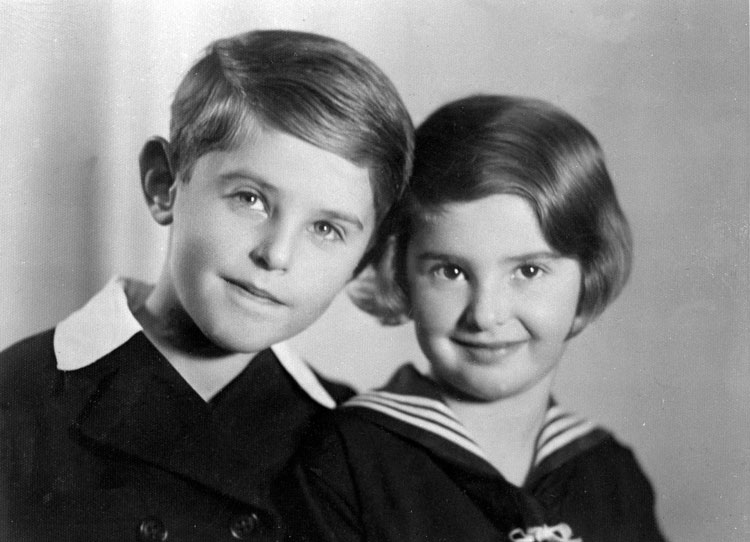
Petr Ginz and his sister Eva Ginz.
Petr was a child prodigy. Before he was even fourteen, he had already written five short novels where he made his own illustrations. He was interested in literature, history, paintings, geography, sociology and also in the technical fields. At the the Terezín concentration camp, Petr and some other boys together founded a magazine called Vedem, which they hand-produced by smuggling paper and art supplies into the camp. Petr was the editor-in-chief. The Czech-language literary magazine ran for two years from 1942 to 1944, and published some 800 pages worth of poems, essays, jokes, dialogues, literary reviews, stories, and drawings.
Before Petr was deported to the camp, he kept a diary about his life. It was first published by his sister Eva as Diary of My Brother. The English translation was published in 2007 as “The Diary of Petr Ginz 1941–1942.”
Miriam Wattenberg (Mary Berg)
The diary of Mary Berg was one of the first children's journals to be published which revealed to a wider public the horrors of the Holocaust.
Miriam was born in Poland in 1924 but her mother was an American, which gave her family a privilege, because Jews with American citizenship could be exchanged for German prisoners of war. While hundreds of thousands of Jews were deported to their deaths, Miriam and her family were held at an internment camp in France, waiting for the transfer that would eventually bring them to the US.

For nearly every day during her two-year-stay in Warsaw Ghetto, Miriam observed long queues of people heading down the street to the trains that would take them to Treblinka. She later wrote: “We, who have been rescued from the ghetto, are ashamed to look at each other. Had we the right to save ourselves? Here everything smells of sun and flowers and there—there is only blood, the blood of my own people.”
Shortly after arriving in the US in 1944, her diary was published in American newspapers in serialized form, making it one of the earliest accounts of the Holocaust. Her diary was published as a book the following year.
Tanya Savicheva
Tanya Savicheva’s diary was short, only nine pages long, and filled with only a few words but it became one of the most iconic and powerful image of the horrors of the siege of Leningrad.
Tanya was the youngest of five children in the Savicheva family. She had two sisters, Nina and Zhenya, and two brothers, Mikhail and Leka. The family was going to spend the summer of 1941 in the countryside but the Axis invasion of the Soviet Union ruined their plans. Only Mikhial left earlier to join the partisans while the rest of family stayed in Leningrad. They all worked hard to support the army. Her mother sewed uniforms, Leka worked as a plane operator at the Admiralty Plant, Zhenya worked at the munitions factory, Nina worked at the construction of city defenses, and Uncle Vasya and Uncle Lesha served in the anti-aircraft defense. Tanya, then 11 years old, dug trenches and put out firebombs.
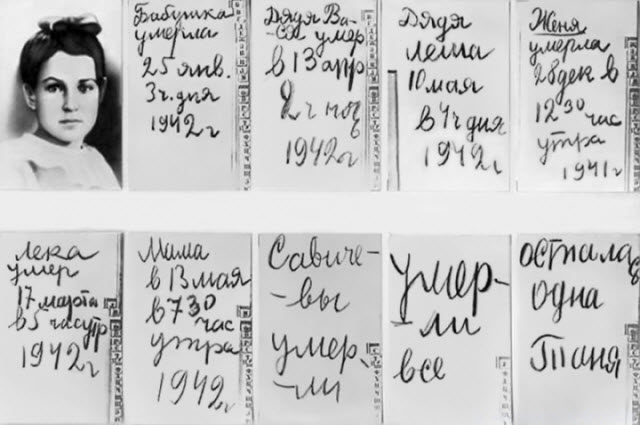
Tanya’s diary, as short as her life.
Tanya had a real diary in the past, a large, thick notebook in which she recorded her day-to-day life. But when the family ran out of fuel to heat the stove, the pages of her diary was used to feed the flames. Sometime later, Tanya was given a small notebook.
As the siege dragged on and food supplies ran out, her family members began to die of starvation one after the other. Tanya used her notebook to record each death. In large handwriting which filled the pages, Tanya wrote:
Zhenya died on December 28th at 12 noon, 1941
Grandma died on the 25th of January at 3 o'clock, 1942
Leka died March 17th, 1942, at 5 o'clock in the morning, 1942
Uncle Vasya died on April 13th at 2 o'clock in the morning, 1942
Uncle Lesha May 10th, at 4 o'clock in the afternoon, 1942
Mama on May 13th at 7:30 in the morning, 1942
The Savichevs are dead
Everyone is dead
Only Tanya is left
Only nine pages long, one page for each sentence, these are the contents of the entire diary.
Tanya didn’t survive the siege. Although she was evacuated out of the city along with about 150 other children, she was already too ill and weak from malnutrition. She died of intestinal tuberculosis in July 1944 at age 14.
Her diary was recovered by her sister Nina, who had survived, unknown to Tanya and her family, when she returned to Leningrad after the war ended. Her short diary was presented as evidence of Nazi atrocities during the Nuremberg Trials. Tanya’s diary is now displayed at the Museum of Leningrad History.
Hélène Berr
Hélène Berr started writing at the age of 21. She wrote about her everyday life in Paris, her studies, her friends, and her growing affection for one young man. Gradually, she began to write about the Nazi occupation and the growing restrictions imposed by the occupiers. Because the Final Solution was never made explicit to the public, Berr was initially unaware of the gas chambers and the mass killings that were taking place. She wondered naively why women and especially children were included in the deportations to the camps.
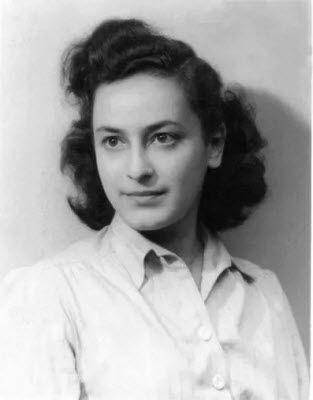
After witnessing the beating and humiliation of a dignified Jewish man, Berr joins a secret network to save Jewish children from deportation. Berr was caught in 1944 and was sent to Bergen-Belsen where she died days before the British liberated the camps. She was 23 years old.
Her diary was published in 2008.
Ruth Maier
Ruth Maier was born in Austria in 1920. Soon after Germany occupied Poland and war broke out, Ruth was able to escape to Norway through her father’s contacts, where she spent three satisfying years. She became fluent in Norwegian within a year, completed her examen artium, that qualified her for studies in any Norwegian university, and befriended the future poet Gunvor Hofmo at a volunteer work camp.
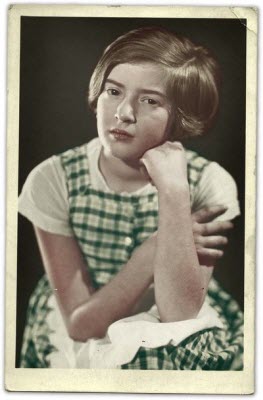
The Germans came to Norway in 1940. Two years later, Ruth was arrested and deported to Auschwitz. On arrival she was led straight to the gas chambers.
Gunvor Hofmo kept Ruth's diaries and much of her correspondence. She originally tried to get her diary published, and approached a publisher but was rejected. It wasn’t until after the death of Gunvor Hofmo, in 1995, when a Norwegian author and poet discovered the diary, and impressed by the journal’s literary values, got it published in 2007. The book was translated to English in 2009.
Philip Slier
Philip Slier was born in Amsterdam in 1923. He was seventeen when the Germans occupied Netherland.
Philip was initially sent to work at a labor camp located just north of Hardenberg. From there he wrote to friends and his family almost daily, giving an eyewitness account of life in the camp. Philip wrote his last letter on 14 September 1942, and then escaped from the camp. He returned to Amsterdam where he remained in hiding for some time moving from one location to another. Philip was about to escape to Switzerland when he was caught and arrested at the railway station trying to board a train.

Philip was moved from camp to camp until he was sent to Sobibor extermination camp in 1943, and was killed by gas chamber.
Philip’s family concealed his letters in their Amsterdam house, where they were discovered more than 50 years later when the house was being demolished. 86 letters, including postcards and a telegram were found hidden in the ceiling of the third floor bathroom. The hidden letters eventually came into the possession of Philip’s cousin, in 1999, who published them as a book called Hidden Letters.
Rywka Lipszyc
Rywka Lipszyc, a Polish-Jewish teenage girl, started writing her diary while living in the Łódź Ghetto. She was deported to Auschwitz-Birkenau concentration camp in August 1944, along with her sisters and cousins. She survived the camp. She also survived a death march to Bergen-Belsen, and lived to see her liberation there in April 1945. But too ill to be evacuated, she was transferred to a hospital in Niendorf, Germany, where she breathed her last. She was 16 years old.
Rywka's diary was unearthed in the ruins of the crematoria at Auschwitz-Birkenau in June 1945 by a Red Army doctor, Zinaida Berezovskaya, who took it with her back to the Soviet Union. Half a century later, Zinaida's granddaughter spotted the manuscript and took it with her. Another decade passed before the diary fell into the hands of the Holocaust Center in San Francisco. The diary was published in English in early 2014.


